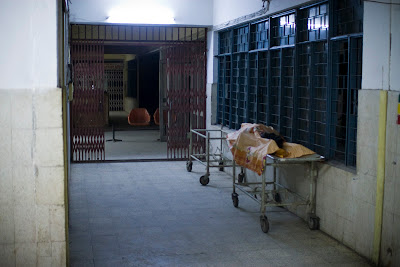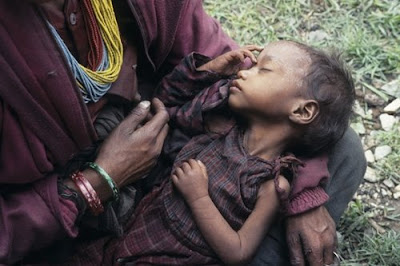At approaching midnight the roads of Kathmandu are dark and quiet. The quietness is good: less dust, less choking fumes from ancient engines, and none of the just-bearable decibels from impatient motorcyclist's horns. The darkness is bad: potholes become invisible and, occasionally, wandering people appear out of nowhere.
I am still trying to comprehend how the accident happened last night. The road along
Ratna park in the heart of Kathmandu is as wide as a racing track, four lanes wide, although the concept of organised lanes doesn't apply here. And like a racing track, the road is one way. Out of the blackness and into the weak beam of my headlight came another cyclist, head on, moving. At 30km/hr, the time between seeing him and collision was less than a short swear word in length.
As a few passing pedestrians formed a crowd around us - us, the two participants in this unlikely stupidity - we sat on the ground trying to understand what had just happened.
The prevailing opinion was that it was my fault as I had a light (so should have seen him coming) and was travelling too fast. This perhaps gave me an insight into the Nepalese view on fault attribution in traffic mishaps (the word the English language press choose for 'accidents'). I was not happy and delivered my tirade to the uncomprehending audience.
"Sir, you maybe give him 1000 Rupees." "Sir, you take to hospital."
"Well, does he have insurance?"
Of course not. I explained once again that this stupid idiot was riding unlit, in dark clothing, the wrong way down a one way street, more or less in the middle of the road, saw me from a distance and
still hit me. And now you want me to take him to hospital and pay for treatment?
I was ready to leave the scene, to go home and clean up my bleeding hand. But then if his wrist was broken, as he seemed to be indicating, the boy sitting on the ground would be in deep trouble.
We got up,
straightened handlebars and drifted towards
Bir hospital,
coincidentally less than 200m away.
While it had a similar strained and exhausted atmosphere of other accident and emergency departments I have visited late at night, it differed in that it looked threadbare, sorrowful and dirty. We sat on a bench and waited. A cleaner came by and we lifted our feet so that she could mop the blood stains from the floor. I asked what work he did. He worked as a cook in a place I didn't know.
"Do you have a ticket sir?" Before being treated it was necessary to be registered and so I was directed outside to the window where name and age were recorded in a computer and 10
Rp charged. Then back inside I was asked to repeat the process as I was not the patient of course. A young doctor in jeans and a hooded top, with a
stethoscope around his neck to confirm that he was a doctor, looked at the boys wrist. An x-ray would be required to check, though he was sure it was not broken.

We followed the green arrows to the x-ray room. We were seen immediately by a friendly (in a lukewarm way) radiographer. While the hand was x-
rayed, I was directed to the pay the 300
Rp that it would cost. Along the way, I passed a person on a bed in the corridor who was either sleeping deeply, or dead. A blanket covered the face so it was hard to tell.

I returned to the x-ray room to see that the boy was having his head x-
rayed for good measure (the collision was not strictly head on as his forehead hit my now swelling shoulder). Would be interesting to have a CAT scan too see if there was a brain in there.

We waited again on the bench with the clean floor underneath our feet and the boy fell asleep. I witnessed a thin and frail man on the bed
in front of me having his genital region exposed and examined. Three policemen walked in and out again with a handcuffed pair of drunken youths.
After 15 minutes we returned to pick up the still-wet x-rays. Behind the counter most of the doctors were sitting huddled around an electric heater. I asked one doctor, probably rather abruptly, to please dry an x-ray for me. "Dry it yourself sir," came the reply. I can understand that it must have been difficult and frustrating for the doctors to do this work in such conditions and I could hear this in her voice.

Now it was over and we could return home. The hooded doctor gave the all clear, prescribing only strong pain killers for the wrist. Forty minutes in all, which was very speedy in comparison to the war zone of any English A&E department on a Saturday night.
We shook our uninjured hands and parted. I continued back along the road where we'd collided and reflected: tomorrow it would be perhaps a little funny and that it could, of course, have been much worse.
 We followed the green arrows to the x-ray room. We were seen immediately by a friendly (in a lukewarm way) radiographer. While the hand was x-rayed, I was directed to the pay the 300 Rp that it would cost. Along the way, I passed a person on a bed in the corridor who was either sleeping deeply, or dead. A blanket covered the face so it was hard to tell.
We followed the green arrows to the x-ray room. We were seen immediately by a friendly (in a lukewarm way) radiographer. While the hand was x-rayed, I was directed to the pay the 300 Rp that it would cost. Along the way, I passed a person on a bed in the corridor who was either sleeping deeply, or dead. A blanket covered the face so it was hard to tell.
 I returned to the x-ray room to see that the boy was having his head x-rayed for good measure (the collision was not strictly head on as his forehead hit my now swelling shoulder). Would be interesting to have a CAT scan too see if there was a brain in there.
I returned to the x-ray room to see that the boy was having his head x-rayed for good measure (the collision was not strictly head on as his forehead hit my now swelling shoulder). Would be interesting to have a CAT scan too see if there was a brain in there.
 We waited again on the bench with the clean floor underneath our feet and the boy fell asleep. I witnessed a thin and frail man on the bed in front of me having his genital region exposed and examined. Three policemen walked in and out again with a handcuffed pair of drunken youths.
After 15 minutes we returned to pick up the still-wet x-rays. Behind the counter most of the doctors were sitting huddled around an electric heater. I asked one doctor, probably rather abruptly, to please dry an x-ray for me. "Dry it yourself sir," came the reply. I can understand that it must have been difficult and frustrating for the doctors to do this work in such conditions and I could hear this in her voice.
We waited again on the bench with the clean floor underneath our feet and the boy fell asleep. I witnessed a thin and frail man on the bed in front of me having his genital region exposed and examined. Three policemen walked in and out again with a handcuffed pair of drunken youths.
After 15 minutes we returned to pick up the still-wet x-rays. Behind the counter most of the doctors were sitting huddled around an electric heater. I asked one doctor, probably rather abruptly, to please dry an x-ray for me. "Dry it yourself sir," came the reply. I can understand that it must have been difficult and frustrating for the doctors to do this work in such conditions and I could hear this in her voice.
 Now it was over and we could return home. The hooded doctor gave the all clear, prescribing only strong pain killers for the wrist. Forty minutes in all, which was very speedy in comparison to the war zone of any English A&E department on a Saturday night.
We shook our uninjured hands and parted. I continued back along the road where we'd collided and reflected: tomorrow it would be perhaps a little funny and that it could, of course, have been much worse.
Now it was over and we could return home. The hooded doctor gave the all clear, prescribing only strong pain killers for the wrist. Forty minutes in all, which was very speedy in comparison to the war zone of any English A&E department on a Saturday night.
We shook our uninjured hands and parted. I continued back along the road where we'd collided and reflected: tomorrow it would be perhaps a little funny and that it could, of course, have been much worse.




